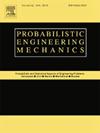A physics-informed neural network enhanced importance sampling (PINN-IS) for data-free reliability analysis
IF 3
3区 工程技术
Q2 ENGINEERING, MECHANICAL
引用次数: 0
Abstract
Reliability analysis of highly sensitive structures is crucial to prevent catastrophic failures and ensure safety. Therefore, these safety-critical systems are to be designed for extremely rare failure events. Accurate statistical quantification of these events associated with a very low probability of occurrence requires millions of evaluations of the limit state function (LSF) involving computationally expensive numerical simulations. Variance reduction techniques like importance sampling (IS) reduce such repetitions to a few thousand. The use of a data-centric metamodel can further cut it down to a few hundred. In data-centric metamodeling approaches, the actual complex numerical analysis is performed at a few points to train the metamodel for approximating the structural response. On the other hand, a physics-informed neural network (PINN) can predict the structural response based on the governing differential equation describing the physics of the problem, without a single evaluation of the complex numerical solver, i.e., data-free. However, the existing PINN models for reliability analysis have been effective only in estimating a large range of failure probabilities (10−1∼10−3). To address this issue, the present study develops a PINN-based data-free reliability analysis for low failure probabilities (<10−5). In doing so, a two-stage PINN integrated with IS (PINN-IS) is proposed. The first stage is employed to approximate the most probable failure point (MPP) appropriately while the second stage enhances the accuracy of LSF predictions at the IS population centred on the approximated MPP. The effectiveness of the proposed approach is numerically illustrated by three structural reliability analysis examples.
用于无数据可靠性分析的物理信息神经网络增强型重要性采样(PINN-IS)
高敏感结构的可靠性分析对于防止灾难性故障和确保安全至关重要。因此,这些安全关键型系统必须针对极其罕见的故障事件进行设计。要对这些发生概率极低的事件进行精确的统计量化,需要对极限状态函数(LSF)进行数百万次评估,其中涉及计算成本高昂的数值模拟。重要度采样(IS)等降低方差技术可将此类重复计算减少到数千次。使用以数据为中心的元模型可将重复次数进一步减少到几百次。在以数据为中心的元模型方法中,实际的复杂数值分析是在几个点上进行的,以训练元模型来逼近结构响应。另一方面,物理信息神经网络(PINN)可以根据描述问题物理特性的控制微分方程预测结构响应,而无需对复杂的数值求解器进行一次评估,即无需数据。然而,现有的用于可靠性分析的 PINN 模型只能有效估计较大范围的失效概率(10-1∼10-3)。针对这一问题,本研究开发了一种基于 PINN 的无数据可靠性分析方法,适用于低故障概率(10-5)。为此,我们提出了一种与 IS 集成的两阶段 PINN(PINN-IS)。第一阶段用于适当近似最可能故障点 (MPP),第二阶段则提高以近似 MPP 为中心的 IS 群的 LSF 预测精度。通过三个结构可靠性分析实例对所提方法的有效性进行了数值说明。
本文章由计算机程序翻译,如有差异,请以英文原文为准。
求助全文
约1分钟内获得全文
求助全文
来源期刊

Probabilistic Engineering Mechanics
工程技术-工程:机械
CiteScore
3.80
自引率
15.40%
发文量
98
审稿时长
13.5 months
期刊介绍:
This journal provides a forum for scholarly work dealing primarily with probabilistic and statistical approaches to contemporary solid/structural and fluid mechanics problems encountered in diverse technical disciplines such as aerospace, civil, marine, mechanical, and nuclear engineering. The journal aims to maintain a healthy balance between general solution techniques and problem-specific results, encouraging a fruitful exchange of ideas among disparate engineering specialities.
 求助内容:
求助内容: 应助结果提醒方式:
应助结果提醒方式:


